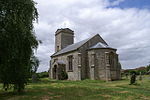Somerset

Somerset ( (listen) SUM-ər-sit, -set; archaically Somersetshire SUM-ər-sit-sheer, -set-, -shər) is a county in South West England which borders Gloucestershire and Bristol to the north, Wiltshire to the east, Dorset to the south-east and Devon to the south-west. It is bounded to the north and west by the Severn Estuary and the Bristol Channel, its coastline facing southeastern Wales. Its traditional border with Gloucestershire is the River Avon. Somerset is currently formed of six council areas, of which two are unitary authorities, until the four second-tier district councils are merged on 1 April 2023, after which the county will comprise three unitary authorities. Its county town is Taunton. Somerset is a rural county of rolling hills, the Blackdown Hills, Mendip Hills, Quantock Hills and Exmoor National Park, and large flat expanses of land including the Somerset Levels. There is evidence of human occupation from Paleolithic times, and of subsequent settlement by the Celts, Romans and Anglo-Saxons. The county played a significant part in Alfred the Great's rise to power, and later the English Civil War and the Monmouth Rebellion. The city of Bath is famous for its Georgian architecture and is a UNESCO World Heritage Site.
Excerpt from the Wikipedia article Somerset (License: CC BY-SA 3.0, Authors, Images).Somerset
A372,
Geographical coordinates (GPS) Address Nearby Places Show on map
Geographical coordinates (GPS)
| Latitude | Longitude |
|---|---|
| N 51.1 ° | E -2.9 ° |
Address
A372
TA7 0NX , Middlezoy
England, United Kingdom
Open on Google Maps










